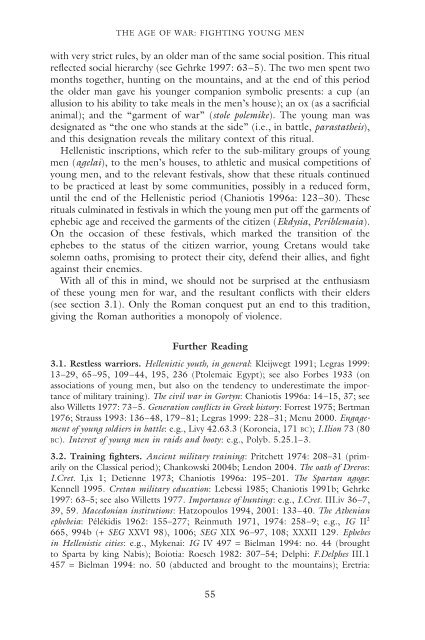WAR IN THE HELLENISTIC WORLD
WAR IN THE HELLENISTIC WORLD
WAR IN THE HELLENISTIC WORLD
You also want an ePaper? Increase the reach of your titles
YUMPU automatically turns print PDFs into web optimized ePapers that Google loves.
<strong>THE</strong> AGE OF <strong>WAR</strong>: FIGHT<strong>IN</strong>G YOUNG MEN<br />
with very strict rules, by an older man of the same social position. This ritual<br />
reflected social hierarchy (see Gehrke 1997: 63–5). The two men spent two<br />
months together, hunting on the mountains, and at the end of this period<br />
the older man gave his younger companion symbolic presents: a cup (an<br />
allusion to his ability to take meals in the men’s house); an ox (as a sacrificial<br />
animal); and the “garment of war” (stole polemike). The young man was<br />
designated as “the one who stands at the side” (i.e., in battle, parastatheis),<br />
and this designation reveals the military context of this ritual.<br />
Hellenistic inscriptions, which refer to the sub-military groups of young<br />
men (agelai), to the men’s houses, to athletic and musical competitions of<br />
young men, and to the relevant festivals, show that these rituals continued<br />
to be practiced at least by some communities, possibly in a reduced form,<br />
until the end of the Hellenistic period (Chaniotis 1996a: 123–30). These<br />
rituals culminated in festivals in which the young men put off the garments of<br />
ephebic age and received the garments of the citizen (Ekdysia, Periblemaia).<br />
On the occasion of these festivals, which marked the transition of the<br />
ephebes to the status of the citizen warrior, young Cretans would take<br />
solemn oaths, promising to protect their city, defend their allies, and fight<br />
against their enemies.<br />
With all of this in mind, we should not be surprised at the enthusiasm<br />
of these young men for war, and the resultant conflicts with their elders<br />
(see section 3.1). Only the Roman conquest put an end to this tradition,<br />
giving the Roman authorities a monopoly of violence.<br />
Further Reading<br />
3.1. Restless warriors. Hellenistic youth, in general: Kleijwegt 1991; Legras 1999:<br />
13–29, 65–95, 109–44, 195, 236 (Ptolemaic Egypt); see also Forbes 1933 (on<br />
associations of young men, but also on the tendency to underestimate the importance<br />
of military training). The civil war in Gortyn: Chaniotis 1996a: 14–15, 37; see<br />
also Willetts 1977: 73–5. Generation conflicts in Greek history: Forrest 1975; Bertman<br />
1976; Strauss 1993: 136–48, 179–81; Legras 1999: 228–31; Menu 2000. Engagement<br />
of young soldiers in battle: e.g., Livy 42.63.3 (Koroneia, 171 BC); I.Ilion 73 (80<br />
BC). Interest of young men in raids and booty: e.g., Polyb. 5.25.1–3.<br />
3.2. Training fighters. Ancient military training: Pritchett 1974: 208–31 (primarily<br />
on the Classical period); Chankowski 2004b; Lendon 2004. The oath of Dreros:<br />
I.Cret. I,ix 1; Detienne 1973; Chaniotis 1996a: 195–201. The Spartan agoge:<br />
Kennell 1995. Cretan military education: Lebessi 1985; Chaniotis 1991b; Gehrke<br />
1997: 63–5; see also Willetts 1977. Importance of hunting: e.g., I.Cret. III.iv 36–7,<br />
39, 59. Macedonian institutions: Hatzopoulos 1994, 2001: 133–40. The Athenian<br />
ephebeia: Pélékidis 1962: 155–277; Reinmuth 1971, 1974: 258–9; e.g., IG II 2<br />
665, 994b (+ SEG XXVI 98), 1006; SEG XIX 96–97, 108; XXXII 129. Ephebes<br />
in Hellenistic cities: e.g., Mykenai: IG IV 497 = Bielman 1994: no. 44 (brought<br />
to Sparta by king Nabis); Boiotia: Roesch 1982: 307–54; Delphi: F.Delphes III.1<br />
457 = Bielman 1994: no. 50 (abducted and brought to the mountains); Eretria:<br />
55
















